Nursing Leadership in Sepsis and Interprofessional Learning Report
VerifiedAdded on 2022/12/29
|7
|2246
|56
Report
AI Summary
This report delves into the critical role of nursing leadership in managing sepsis, a life-threatening condition. It emphasizes the importance of interprofessional learning and the collaborative efforts of a multidisciplinary team, including doctors, nurses, pharmacists, and lab technicians, in providing effective patient care. The report highlights the impact of sepsis on vulnerable populations and discusses the increasing prevalence of the condition. It outlines the 'Sepsis Six' pathway, a crucial tool for early diagnosis and treatment, and underscores the benefits of interprofessional learning in enhancing patient outcomes. The report also includes a short quiz to test understanding of key concepts related to sepsis and its management, emphasizing the importance of early intervention and collaborative care. The conclusion reiterates the significance of addressing sepsis promptly through evidence-based practices and interprofessional skills to improve patient outcomes. References are provided for further study. This report is available on Desklib, a platform offering past papers and solutions to aid students.
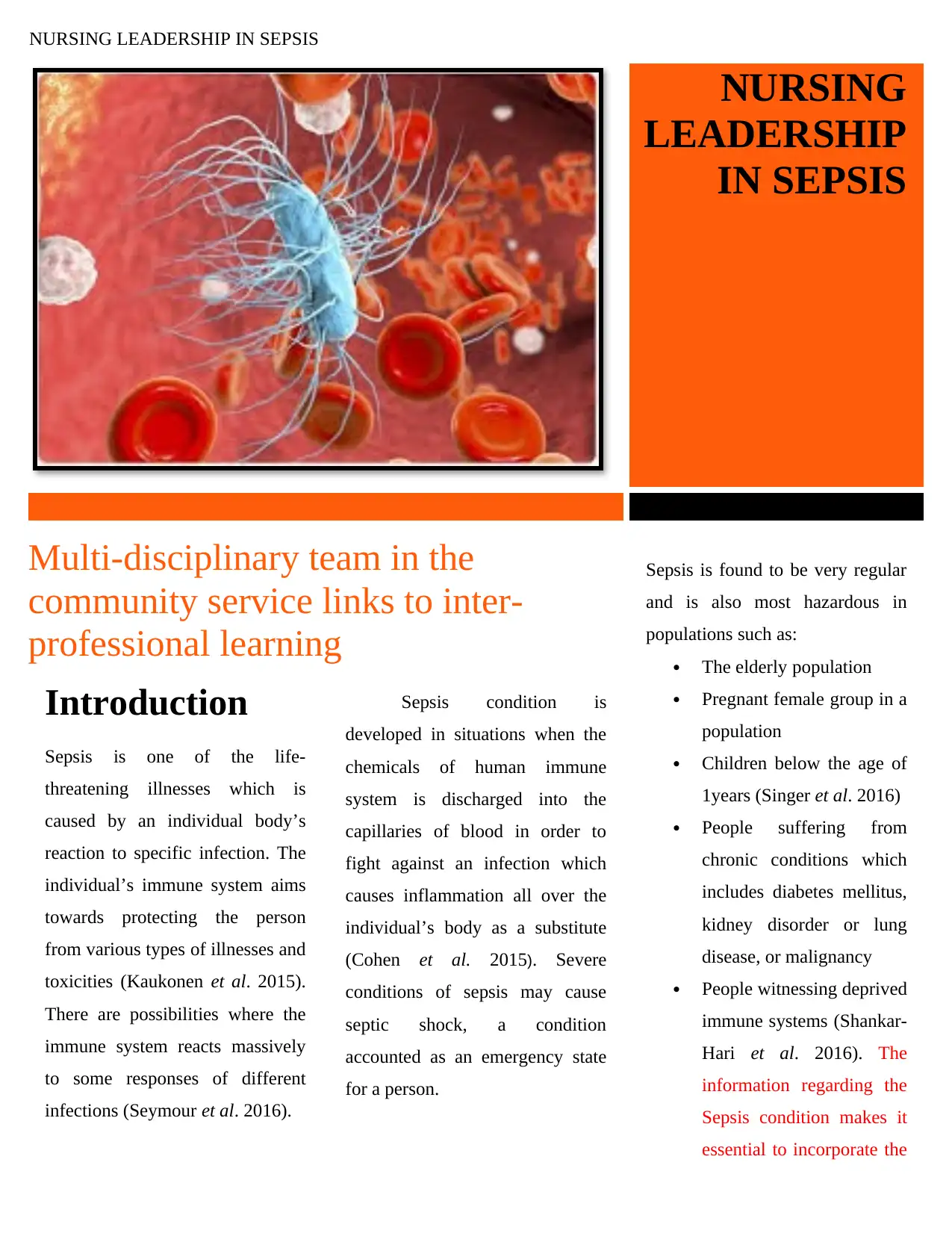
NURSING LEADERSHIP IN SEPSIS
NURSING
LEADERSHIP
IN SEPSIS
Introduction
Sepsis is one of the life-
threatening illnesses which is
caused by an individual body’s
reaction to specific infection. The
individual’s immune system aims
towards protecting the person
from various types of illnesses and
toxicities (Kaukonen et al. 2015).
There are possibilities where the
immune system reacts massively
to some responses of different
infections (Seymour et al. 2016).
Sepsis condition is
developed in situations when the
chemicals of human immune
system is discharged into the
capillaries of blood in order to
fight against an infection which
causes inflammation all over the
individual’s body as a substitute
(Cohen et al. 2015). Severe
conditions of sepsis may cause
septic shock, a condition
accounted as an emergency state
for a person.
Sepsis is found to be very regular
and is also most hazardous in
populations such as:
The elderly population
Pregnant female group in a
population
Children below the age of
1years (Singer et al. 2016)
People suffering from
chronic conditions which
includes diabetes mellitus,
kidney disorder or lung
disease, or malignancy
People witnessing deprived
immune systems (Shankar-
Hari et al. 2016). The
information regarding the
Sepsis condition makes it
essential to incorporate the
Multi-disciplinary team in the
community service links to inter-
professional learning
NURSING
LEADERSHIP
IN SEPSIS
Introduction
Sepsis is one of the life-
threatening illnesses which is
caused by an individual body’s
reaction to specific infection. The
individual’s immune system aims
towards protecting the person
from various types of illnesses and
toxicities (Kaukonen et al. 2015).
There are possibilities where the
immune system reacts massively
to some responses of different
infections (Seymour et al. 2016).
Sepsis condition is
developed in situations when the
chemicals of human immune
system is discharged into the
capillaries of blood in order to
fight against an infection which
causes inflammation all over the
individual’s body as a substitute
(Cohen et al. 2015). Severe
conditions of sepsis may cause
septic shock, a condition
accounted as an emergency state
for a person.
Sepsis is found to be very regular
and is also most hazardous in
populations such as:
The elderly population
Pregnant female group in a
population
Children below the age of
1years (Singer et al. 2016)
People suffering from
chronic conditions which
includes diabetes mellitus,
kidney disorder or lung
disease, or malignancy
People witnessing deprived
immune systems (Shankar-
Hari et al. 2016). The
information regarding the
Sepsis condition makes it
essential to incorporate the
Multi-disciplinary team in the
community service links to inter-
professional learning
Paraphrase This Document
Need a fresh take? Get an instant paraphrase of this document with our AI Paraphraser
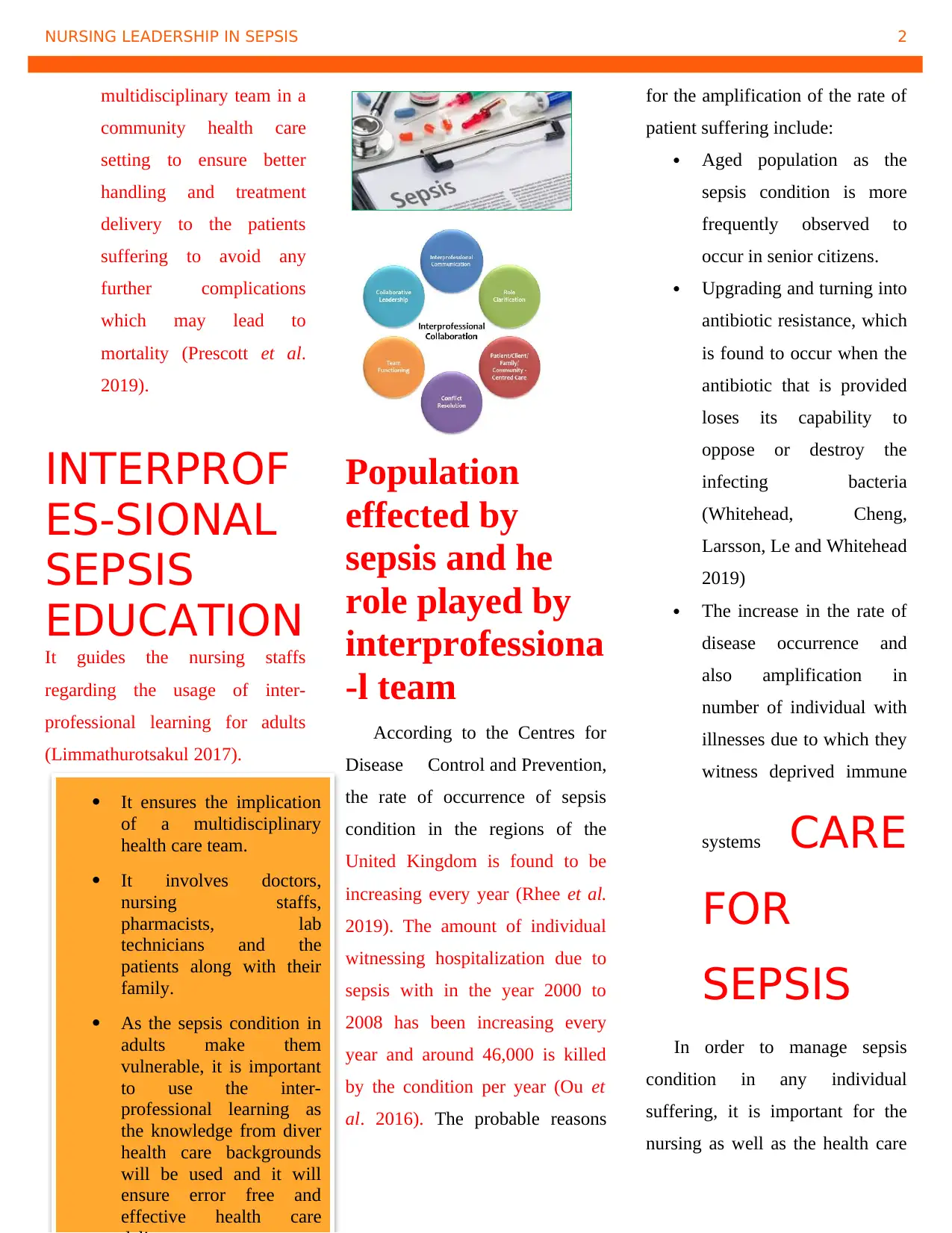
NURSING LEADERSHIP IN SEPSIS 2
multidisciplinary team in a
community health care
setting to ensure better
handling and treatment
delivery to the patients
suffering to avoid any
further complications
which may lead to
mortality (Prescott et al.
2019).
INTERPROF
ES-SIONAL
SEPSIS
EDUCATION
It guides the nursing staffs
regarding the usage of inter-
professional learning for adults
(Limmathurotsakul 2017).
Population
effected by
sepsis and he
role played by
interprofessiona
-l team
According to the Centres for
Disease Control and Prevention,
the rate of occurrence of sepsis
condition in the regions of the
United Kingdom is found to be
increasing every year (Rhee et al.
2019). The amount of individual
witnessing hospitalization due to
sepsis with in the year 2000 to
2008 has been increasing every
year and around 46,000 is killed
by the condition per year (Ou et
al. 2016). The probable reasons
for the amplification of the rate of
patient suffering include:
Aged population as the
sepsis condition is more
frequently observed to
occur in senior citizens.
Upgrading and turning into
antibiotic resistance, which
is found to occur when the
antibiotic that is provided
loses its capability to
oppose or destroy the
infecting bacteria
(Whitehead, Cheng,
Larsson, Le and Whitehead
2019)
The increase in the rate of
disease occurrence and
also amplification in
number of individual with
illnesses due to which they
witness deprived immune
systems CARE
FOR
SEPSIS
In order to manage sepsis
condition in any individual
suffering, it is important for the
nursing as well as the health care
It ensures the implication
of a multidisciplinary
health care team.
It involves doctors,
nursing staffs,
pharmacists, lab
technicians and the
patients along with their
family.
As the sepsis condition in
adults make them
vulnerable, it is important
to use the inter-
professional learning as
the knowledge from diver
health care backgrounds
will be used and it will
ensure error free and
effective health care
multidisciplinary team in a
community health care
setting to ensure better
handling and treatment
delivery to the patients
suffering to avoid any
further complications
which may lead to
mortality (Prescott et al.
2019).
INTERPROF
ES-SIONAL
SEPSIS
EDUCATION
It guides the nursing staffs
regarding the usage of inter-
professional learning for adults
(Limmathurotsakul 2017).
Population
effected by
sepsis and he
role played by
interprofessiona
-l team
According to the Centres for
Disease Control and Prevention,
the rate of occurrence of sepsis
condition in the regions of the
United Kingdom is found to be
increasing every year (Rhee et al.
2019). The amount of individual
witnessing hospitalization due to
sepsis with in the year 2000 to
2008 has been increasing every
year and around 46,000 is killed
by the condition per year (Ou et
al. 2016). The probable reasons
for the amplification of the rate of
patient suffering include:
Aged population as the
sepsis condition is more
frequently observed to
occur in senior citizens.
Upgrading and turning into
antibiotic resistance, which
is found to occur when the
antibiotic that is provided
loses its capability to
oppose or destroy the
infecting bacteria
(Whitehead, Cheng,
Larsson, Le and Whitehead
2019)
The increase in the rate of
disease occurrence and
also amplification in
number of individual with
illnesses due to which they
witness deprived immune
systems CARE
FOR
SEPSIS
In order to manage sepsis
condition in any individual
suffering, it is important for the
nursing as well as the health care
It ensures the implication
of a multidisciplinary
health care team.
It involves doctors,
nursing staffs,
pharmacists, lab
technicians and the
patients along with their
family.
As the sepsis condition in
adults make them
vulnerable, it is important
to use the inter-
professional learning as
the knowledge from diver
health care backgrounds
will be used and it will
ensure error free and
effective health care
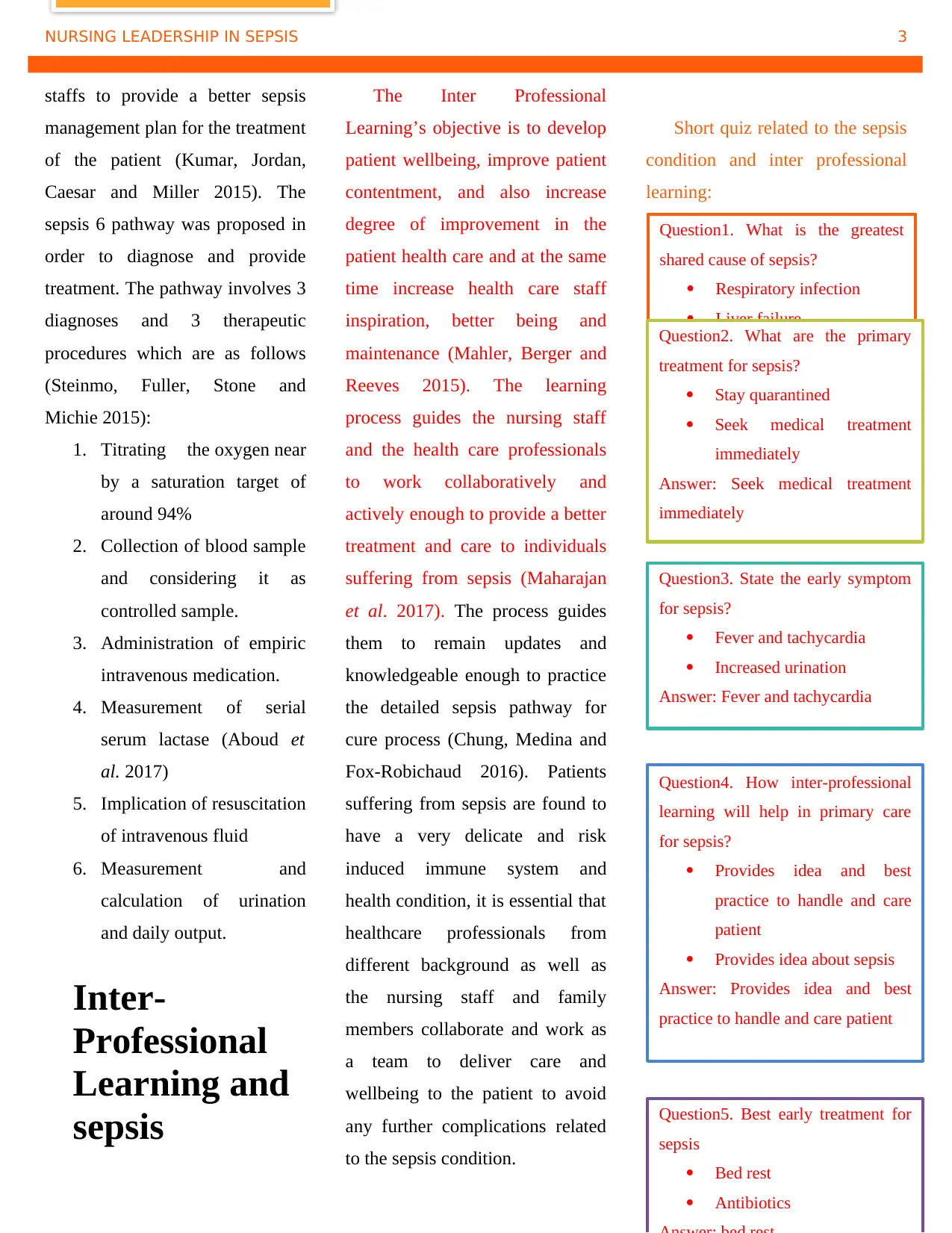
NURSING LEADERSHIP IN SEPSIS 3
staffs to provide a better sepsis
management plan for the treatment
of the patient (Kumar, Jordan,
Caesar and Miller 2015). The
sepsis 6 pathway was proposed in
order to diagnose and provide
treatment. The pathway involves 3
diagnoses and 3 therapeutic
procedures which are as follows
(Steinmo, Fuller, Stone and
Michie 2015):
1. Titrating the oxygen near
by a saturation target of
around 94%
2. Collection of blood sample
and considering it as
controlled sample.
3. Administration of empiric
intravenous medication.
4. Measurement of serial
serum lactase (Aboud et
al. 2017)
5. Implication of resuscitation
of intravenous fluid
6. Measurement and
calculation of urination
and daily output.
Inter-
Professional
Learning and
sepsis
The Inter Professional
Learning’s objective is to develop
patient wellbeing, improve patient
contentment, and also increase
degree of improvement in the
patient health care and at the same
time increase health care staff
inspiration, better being and
maintenance (Mahler, Berger and
Reeves 2015). The learning
process guides the nursing staff
and the health care professionals
to work collaboratively and
actively enough to provide a better
treatment and care to individuals
suffering from sepsis (Maharajan
et al. 2017). The process guides
them to remain updates and
knowledgeable enough to practice
the detailed sepsis pathway for
cure process (Chung, Medina and
Fox-Robichaud 2016). Patients
suffering from sepsis are found to
have a very delicate and risk
induced immune system and
health condition, it is essential that
healthcare professionals from
different background as well as
the nursing staff and family
members collaborate and work as
a team to deliver care and
wellbeing to the patient to avoid
any further complications related
to the sepsis condition.
Short quiz related to the sepsis
condition and inter professional
learning:
\
Question1. What is the greatest
shared cause of sepsis?
Respiratory infection
Liver failure
Answer: respiratory infection
Question2. What are the primary
treatment for sepsis?
Stay quarantined
Seek medical treatment
immediately
Answer: Seek medical treatment
immediately
Question3. State the early symptom
for sepsis?
Fever and tachycardia
Increased urination
Answer: Fever and tachycardia
Question4. How inter-professional
learning will help in primary care
for sepsis?
Provides idea and best
practice to handle and care
patient
Provides idea about sepsis
Answer: Provides idea and best
practice to handle and care patient
Question5. Best early treatment for
sepsis
Bed rest
Antibiotics
staffs to provide a better sepsis
management plan for the treatment
of the patient (Kumar, Jordan,
Caesar and Miller 2015). The
sepsis 6 pathway was proposed in
order to diagnose and provide
treatment. The pathway involves 3
diagnoses and 3 therapeutic
procedures which are as follows
(Steinmo, Fuller, Stone and
Michie 2015):
1. Titrating the oxygen near
by a saturation target of
around 94%
2. Collection of blood sample
and considering it as
controlled sample.
3. Administration of empiric
intravenous medication.
4. Measurement of serial
serum lactase (Aboud et
al. 2017)
5. Implication of resuscitation
of intravenous fluid
6. Measurement and
calculation of urination
and daily output.
Inter-
Professional
Learning and
sepsis
The Inter Professional
Learning’s objective is to develop
patient wellbeing, improve patient
contentment, and also increase
degree of improvement in the
patient health care and at the same
time increase health care staff
inspiration, better being and
maintenance (Mahler, Berger and
Reeves 2015). The learning
process guides the nursing staff
and the health care professionals
to work collaboratively and
actively enough to provide a better
treatment and care to individuals
suffering from sepsis (Maharajan
et al. 2017). The process guides
them to remain updates and
knowledgeable enough to practice
the detailed sepsis pathway for
cure process (Chung, Medina and
Fox-Robichaud 2016). Patients
suffering from sepsis are found to
have a very delicate and risk
induced immune system and
health condition, it is essential that
healthcare professionals from
different background as well as
the nursing staff and family
members collaborate and work as
a team to deliver care and
wellbeing to the patient to avoid
any further complications related
to the sepsis condition.
Short quiz related to the sepsis
condition and inter professional
learning:
\
Question1. What is the greatest
shared cause of sepsis?
Respiratory infection
Liver failure
Answer: respiratory infection
Question2. What are the primary
treatment for sepsis?
Stay quarantined
Seek medical treatment
immediately
Answer: Seek medical treatment
immediately
Question3. State the early symptom
for sepsis?
Fever and tachycardia
Increased urination
Answer: Fever and tachycardia
Question4. How inter-professional
learning will help in primary care
for sepsis?
Provides idea and best
practice to handle and care
patient
Provides idea about sepsis
Answer: Provides idea and best
practice to handle and care patient
Question5. Best early treatment for
sepsis
Bed rest
Antibiotics
⊘ This is a preview!⊘
Do you want full access?
Subscribe today to unlock all pages.

Trusted by 1+ million students worldwide
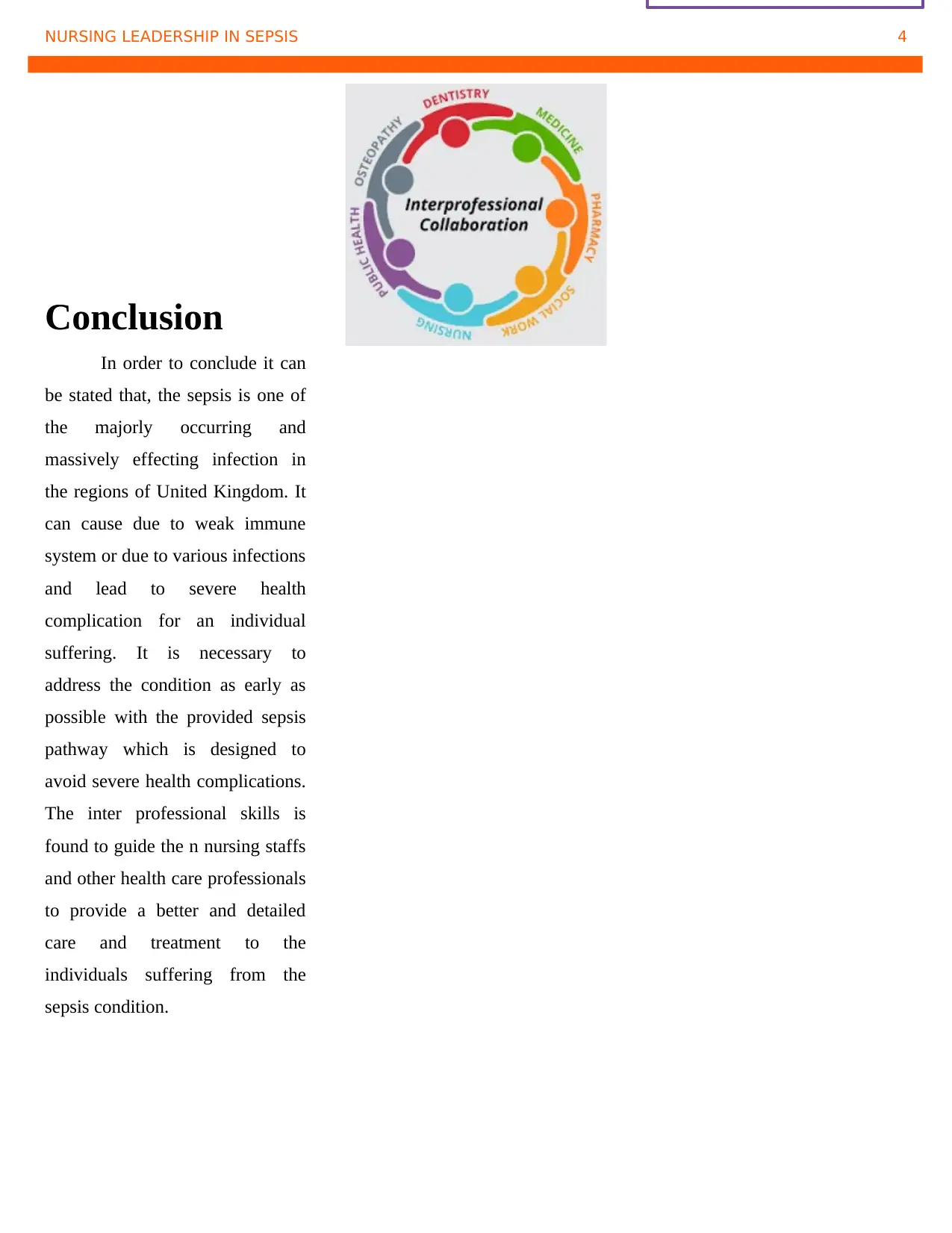
NURSING LEADERSHIP IN SEPSIS 4
Conclusion
In order to conclude it can
be stated that, the sepsis is one of
the majorly occurring and
massively effecting infection in
the regions of United Kingdom. It
can cause due to weak immune
system or due to various infections
and lead to severe health
complication for an individual
suffering. It is necessary to
address the condition as early as
possible with the provided sepsis
pathway which is designed to
avoid severe health complications.
The inter professional skills is
found to guide the n nursing staffs
and other health care professionals
to provide a better and detailed
care and treatment to the
individuals suffering from the
sepsis condition.
Conclusion
In order to conclude it can
be stated that, the sepsis is one of
the majorly occurring and
massively effecting infection in
the regions of United Kingdom. It
can cause due to weak immune
system or due to various infections
and lead to severe health
complication for an individual
suffering. It is necessary to
address the condition as early as
possible with the provided sepsis
pathway which is designed to
avoid severe health complications.
The inter professional skills is
found to guide the n nursing staffs
and other health care professionals
to provide a better and detailed
care and treatment to the
individuals suffering from the
sepsis condition.
Paraphrase This Document
Need a fresh take? Get an instant paraphrase of this document with our AI Paraphraser
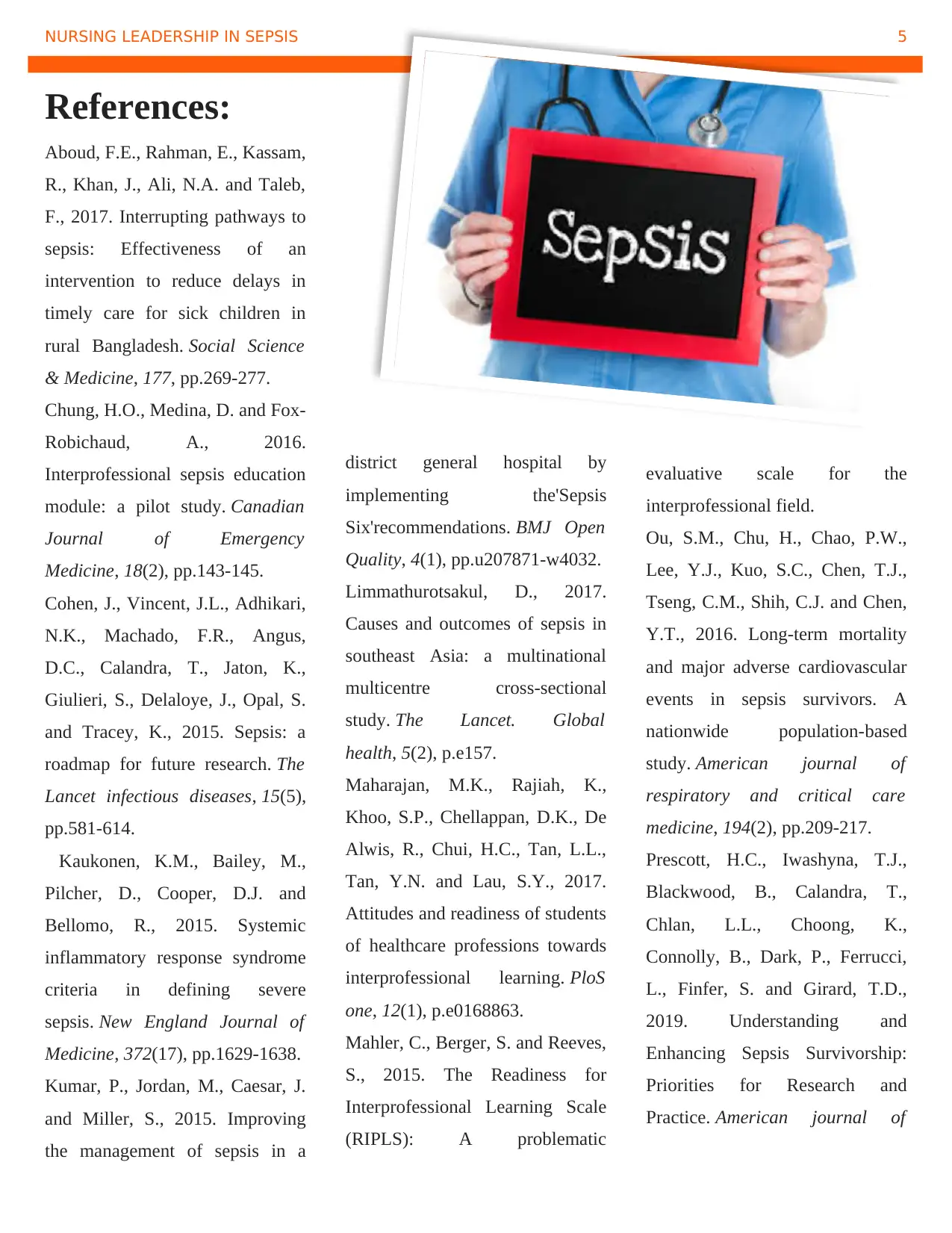
NURSING LEADERSHIP IN SEPSIS 5
References:
Aboud, F.E., Rahman, E., Kassam,
R., Khan, J., Ali, N.A. and Taleb,
F., 2017. Interrupting pathways to
sepsis: Effectiveness of an
intervention to reduce delays in
timely care for sick children in
rural Bangladesh. Social Science
& Medicine, 177, pp.269-277.
Chung, H.O., Medina, D. and Fox-
Robichaud, A., 2016.
Interprofessional sepsis education
module: a pilot study. Canadian
Journal of Emergency
Medicine, 18(2), pp.143-145.
Cohen, J., Vincent, J.L., Adhikari,
N.K., Machado, F.R., Angus,
D.C., Calandra, T., Jaton, K.,
Giulieri, S., Delaloye, J., Opal, S.
and Tracey, K., 2015. Sepsis: a
roadmap for future research. The
Lancet infectious diseases, 15(5),
pp.581-614.
Kaukonen, K.M., Bailey, M.,
Pilcher, D., Cooper, D.J. and
Bellomo, R., 2015. Systemic
inflammatory response syndrome
criteria in defining severe
sepsis. New England Journal of
Medicine, 372(17), pp.1629-1638.
Kumar, P., Jordan, M., Caesar, J.
and Miller, S., 2015. Improving
the management of sepsis in a
district general hospital by
implementing the'Sepsis
Six'recommendations. BMJ Open
Quality, 4(1), pp.u207871-w4032.
Limmathurotsakul, D., 2017.
Causes and outcomes of sepsis in
southeast Asia: a multinational
multicentre cross-sectional
study. The Lancet. Global
health, 5(2), p.e157.
Maharajan, M.K., Rajiah, K.,
Khoo, S.P., Chellappan, D.K., De
Alwis, R., Chui, H.C., Tan, L.L.,
Tan, Y.N. and Lau, S.Y., 2017.
Attitudes and readiness of students
of healthcare professions towards
interprofessional learning. PloS
one, 12(1), p.e0168863.
Mahler, C., Berger, S. and Reeves,
S., 2015. The Readiness for
Interprofessional Learning Scale
(RIPLS): A problematic
evaluative scale for the
interprofessional field.
Ou, S.M., Chu, H., Chao, P.W.,
Lee, Y.J., Kuo, S.C., Chen, T.J.,
Tseng, C.M., Shih, C.J. and Chen,
Y.T., 2016. Long-term mortality
and major adverse cardiovascular
events in sepsis survivors. A
nationwide population-based
study. American journal of
respiratory and critical care
medicine, 194(2), pp.209-217.
Prescott, H.C., Iwashyna, T.J.,
Blackwood, B., Calandra, T.,
Chlan, L.L., Choong, K.,
Connolly, B., Dark, P., Ferrucci,
L., Finfer, S. and Girard, T.D.,
2019. Understanding and
Enhancing Sepsis Survivorship:
Priorities for Research and
Practice. American journal of
References:
Aboud, F.E., Rahman, E., Kassam,
R., Khan, J., Ali, N.A. and Taleb,
F., 2017. Interrupting pathways to
sepsis: Effectiveness of an
intervention to reduce delays in
timely care for sick children in
rural Bangladesh. Social Science
& Medicine, 177, pp.269-277.
Chung, H.O., Medina, D. and Fox-
Robichaud, A., 2016.
Interprofessional sepsis education
module: a pilot study. Canadian
Journal of Emergency
Medicine, 18(2), pp.143-145.
Cohen, J., Vincent, J.L., Adhikari,
N.K., Machado, F.R., Angus,
D.C., Calandra, T., Jaton, K.,
Giulieri, S., Delaloye, J., Opal, S.
and Tracey, K., 2015. Sepsis: a
roadmap for future research. The
Lancet infectious diseases, 15(5),
pp.581-614.
Kaukonen, K.M., Bailey, M.,
Pilcher, D., Cooper, D.J. and
Bellomo, R., 2015. Systemic
inflammatory response syndrome
criteria in defining severe
sepsis. New England Journal of
Medicine, 372(17), pp.1629-1638.
Kumar, P., Jordan, M., Caesar, J.
and Miller, S., 2015. Improving
the management of sepsis in a
district general hospital by
implementing the'Sepsis
Six'recommendations. BMJ Open
Quality, 4(1), pp.u207871-w4032.
Limmathurotsakul, D., 2017.
Causes and outcomes of sepsis in
southeast Asia: a multinational
multicentre cross-sectional
study. The Lancet. Global
health, 5(2), p.e157.
Maharajan, M.K., Rajiah, K.,
Khoo, S.P., Chellappan, D.K., De
Alwis, R., Chui, H.C., Tan, L.L.,
Tan, Y.N. and Lau, S.Y., 2017.
Attitudes and readiness of students
of healthcare professions towards
interprofessional learning. PloS
one, 12(1), p.e0168863.
Mahler, C., Berger, S. and Reeves,
S., 2015. The Readiness for
Interprofessional Learning Scale
(RIPLS): A problematic
evaluative scale for the
interprofessional field.
Ou, S.M., Chu, H., Chao, P.W.,
Lee, Y.J., Kuo, S.C., Chen, T.J.,
Tseng, C.M., Shih, C.J. and Chen,
Y.T., 2016. Long-term mortality
and major adverse cardiovascular
events in sepsis survivors. A
nationwide population-based
study. American journal of
respiratory and critical care
medicine, 194(2), pp.209-217.
Prescott, H.C., Iwashyna, T.J.,
Blackwood, B., Calandra, T.,
Chlan, L.L., Choong, K.,
Connolly, B., Dark, P., Ferrucci,
L., Finfer, S. and Girard, T.D.,
2019. Understanding and
Enhancing Sepsis Survivorship:
Priorities for Research and
Practice. American journal of
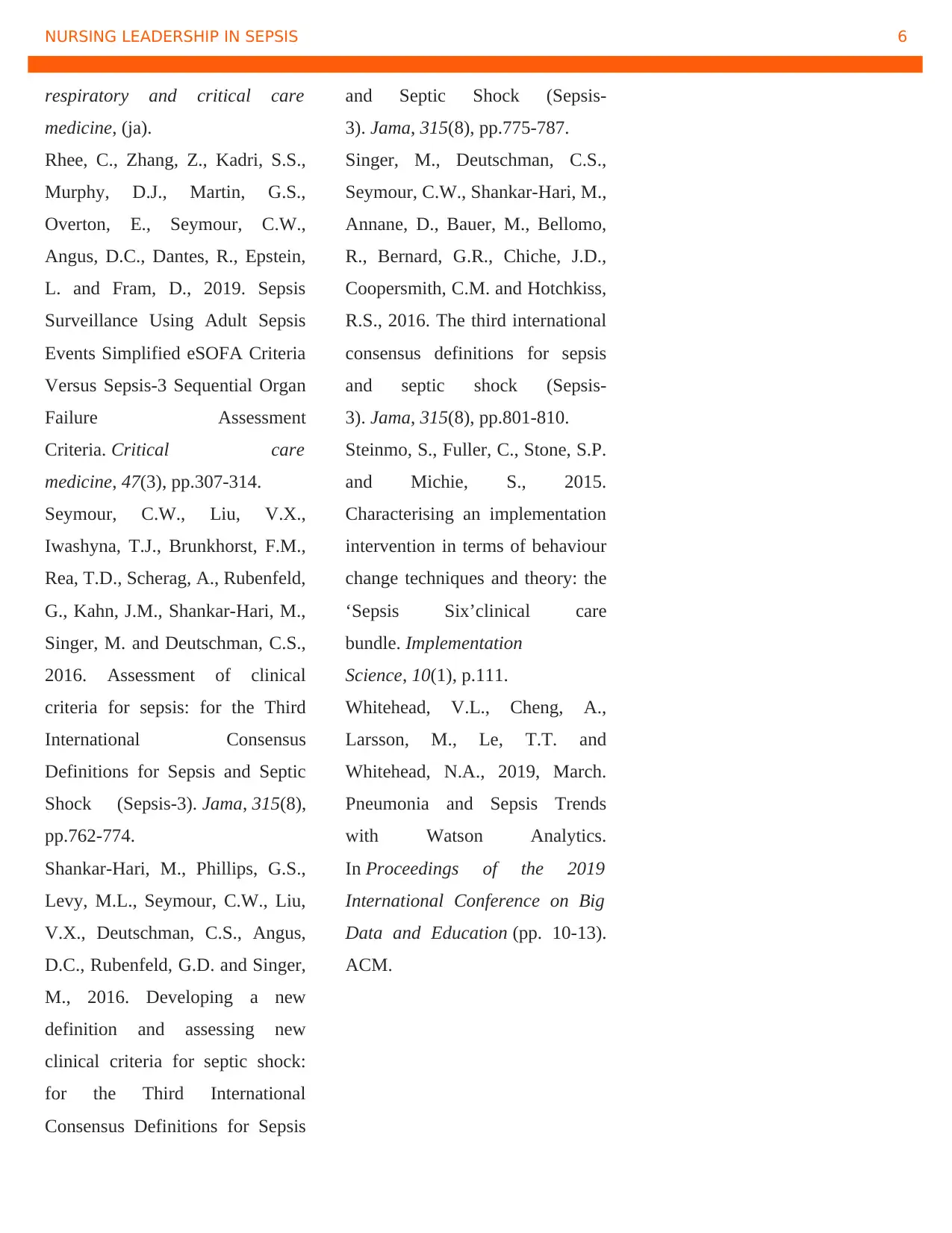
NURSING LEADERSHIP IN SEPSIS 6
respiratory and critical care
medicine, (ja).
Rhee, C., Zhang, Z., Kadri, S.S.,
Murphy, D.J., Martin, G.S.,
Overton, E., Seymour, C.W.,
Angus, D.C., Dantes, R., Epstein,
L. and Fram, D., 2019. Sepsis
Surveillance Using Adult Sepsis
Events Simplified eSOFA Criteria
Versus Sepsis-3 Sequential Organ
Failure Assessment
Criteria. Critical care
medicine, 47(3), pp.307-314.
Seymour, C.W., Liu, V.X.,
Iwashyna, T.J., Brunkhorst, F.M.,
Rea, T.D., Scherag, A., Rubenfeld,
G., Kahn, J.M., Shankar-Hari, M.,
Singer, M. and Deutschman, C.S.,
2016. Assessment of clinical
criteria for sepsis: for the Third
International Consensus
Definitions for Sepsis and Septic
Shock (Sepsis-3). Jama, 315(8),
pp.762-774.
Shankar-Hari, M., Phillips, G.S.,
Levy, M.L., Seymour, C.W., Liu,
V.X., Deutschman, C.S., Angus,
D.C., Rubenfeld, G.D. and Singer,
M., 2016. Developing a new
definition and assessing new
clinical criteria for septic shock:
for the Third International
Consensus Definitions for Sepsis
and Septic Shock (Sepsis-
3). Jama, 315(8), pp.775-787.
Singer, M., Deutschman, C.S.,
Seymour, C.W., Shankar-Hari, M.,
Annane, D., Bauer, M., Bellomo,
R., Bernard, G.R., Chiche, J.D.,
Coopersmith, C.M. and Hotchkiss,
R.S., 2016. The third international
consensus definitions for sepsis
and septic shock (Sepsis-
3). Jama, 315(8), pp.801-810.
Steinmo, S., Fuller, C., Stone, S.P.
and Michie, S., 2015.
Characterising an implementation
intervention in terms of behaviour
change techniques and theory: the
‘Sepsis Six’clinical care
bundle. Implementation
Science, 10(1), p.111.
Whitehead, V.L., Cheng, A.,
Larsson, M., Le, T.T. and
Whitehead, N.A., 2019, March.
Pneumonia and Sepsis Trends
with Watson Analytics.
In Proceedings of the 2019
International Conference on Big
Data and Education (pp. 10-13).
ACM.
respiratory and critical care
medicine, (ja).
Rhee, C., Zhang, Z., Kadri, S.S.,
Murphy, D.J., Martin, G.S.,
Overton, E., Seymour, C.W.,
Angus, D.C., Dantes, R., Epstein,
L. and Fram, D., 2019. Sepsis
Surveillance Using Adult Sepsis
Events Simplified eSOFA Criteria
Versus Sepsis-3 Sequential Organ
Failure Assessment
Criteria. Critical care
medicine, 47(3), pp.307-314.
Seymour, C.W., Liu, V.X.,
Iwashyna, T.J., Brunkhorst, F.M.,
Rea, T.D., Scherag, A., Rubenfeld,
G., Kahn, J.M., Shankar-Hari, M.,
Singer, M. and Deutschman, C.S.,
2016. Assessment of clinical
criteria for sepsis: for the Third
International Consensus
Definitions for Sepsis and Septic
Shock (Sepsis-3). Jama, 315(8),
pp.762-774.
Shankar-Hari, M., Phillips, G.S.,
Levy, M.L., Seymour, C.W., Liu,
V.X., Deutschman, C.S., Angus,
D.C., Rubenfeld, G.D. and Singer,
M., 2016. Developing a new
definition and assessing new
clinical criteria for septic shock:
for the Third International
Consensus Definitions for Sepsis
and Septic Shock (Sepsis-
3). Jama, 315(8), pp.775-787.
Singer, M., Deutschman, C.S.,
Seymour, C.W., Shankar-Hari, M.,
Annane, D., Bauer, M., Bellomo,
R., Bernard, G.R., Chiche, J.D.,
Coopersmith, C.M. and Hotchkiss,
R.S., 2016. The third international
consensus definitions for sepsis
and septic shock (Sepsis-
3). Jama, 315(8), pp.801-810.
Steinmo, S., Fuller, C., Stone, S.P.
and Michie, S., 2015.
Characterising an implementation
intervention in terms of behaviour
change techniques and theory: the
‘Sepsis Six’clinical care
bundle. Implementation
Science, 10(1), p.111.
Whitehead, V.L., Cheng, A.,
Larsson, M., Le, T.T. and
Whitehead, N.A., 2019, March.
Pneumonia and Sepsis Trends
with Watson Analytics.
In Proceedings of the 2019
International Conference on Big
Data and Education (pp. 10-13).
ACM.
⊘ This is a preview!⊘
Do you want full access?
Subscribe today to unlock all pages.

Trusted by 1+ million students worldwide

NURSING LEADERSHIP IN SEPSIS 7
HEADING 4
HEADING 4
1 out of 7
Related Documents
Your All-in-One AI-Powered Toolkit for Academic Success.
+13062052269
info@desklib.com
Available 24*7 on WhatsApp / Email
![[object Object]](/_next/static/media/star-bottom.7253800d.svg)
Unlock your academic potential
Copyright © 2020–2026 A2Z Services. All Rights Reserved. Developed and managed by ZUCOL.





